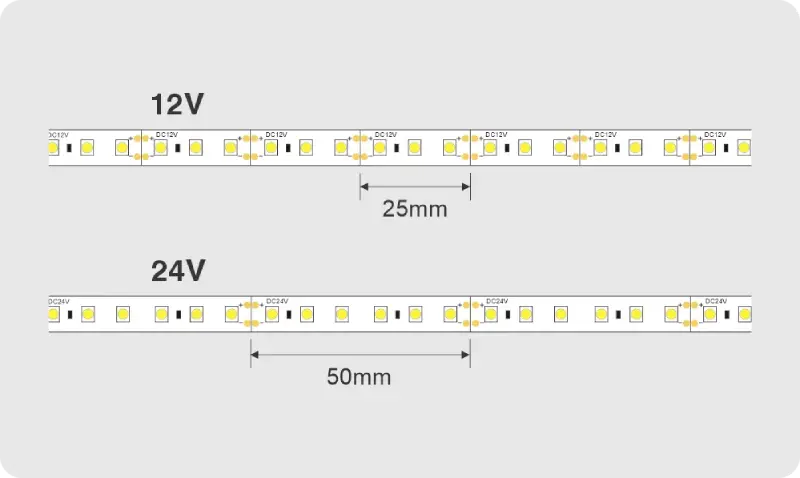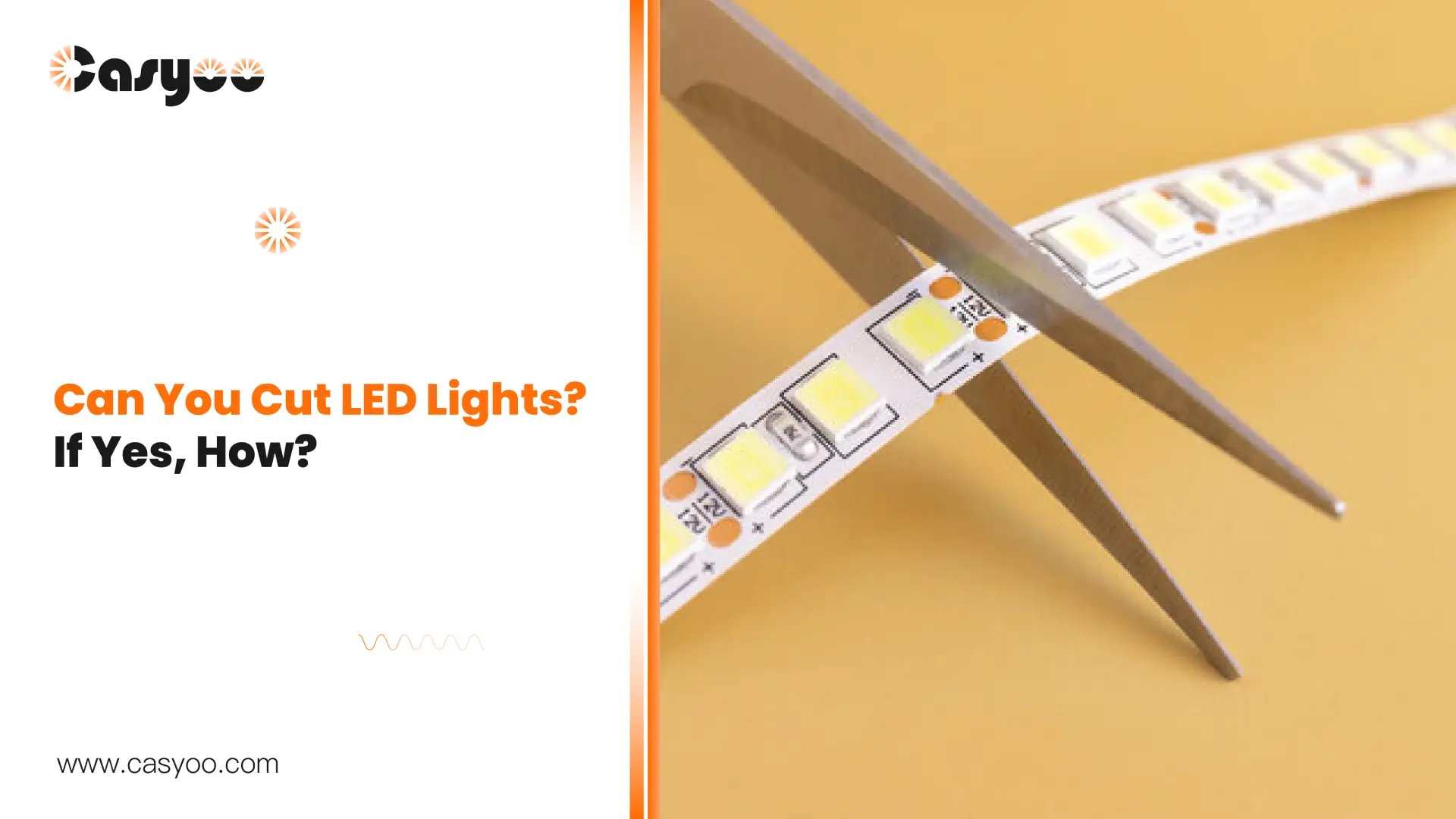It happens to everyone that sometimes the LED light strips we bought are too long to install. Can you cut the LED strips anywhere to make them perfectly fit the places you plan to put them? I’m afraid the answer is no. But can you cut LED lights? If in the right way, yes. Read this passage about how to cut LED strip lights without damaging them, which kinds of LED strips you cannot cut, and how to deal with common faults after cutting the strips!
Can you cut LED lights?
Soft light strips
The soft light strips that are used in homes can be cut, but not to any length. They usually have a minimum cutting distance requirement. 12V DC input and 24V DC input soft light strips are the most commonly used types of light strips. The minimum cutting unit of the 24V light strip is generally 50mm or 100mm, while the minimum cutting unit of the 12V light strip is generally 50mm or 25mm. Generally, the copper-colored solder pad with small scissors marks and a black line is used as the boundary for cutting. This is where to cut LED strip lights to ensure they function properly.

High-voltage light strips
High-voltage light strips use the grid voltage, which is usually 220 V or 110 V, so it is not recommended to cut them because cutting these strips may cause accidents like leakage and electric shock. If there are cutting points on the strips and the manufacturer has confirmed the strips can be cut, they are usually cut every 1 m or even 2 m. Assuming that we only need 2.5 m of light strips, we will cut 3 m, and then fold half meter of the strip or cover it with the black tape. All operations should be performed by professional electricians.
Waterproof light strips
Another type of light strip that we don’t recommend cutting is the waterproof light strip. These strips may have an IP 65~68 waterproof rating. Even if the waterproof LED light strip is cut from the cutting point, it still cannot be used normally for a long time because it is difficult for users to restore the original waterproof process intact. In humid or rainy days, rain and water vapor will penetrate into the lamp body through the cutting position, causing damage to the lamp beads and other components. Can you cut waterproof LED strips? it’s not recommended due to the risk of compromising their waterproof integrity.
How do you cut and reconnect LED lights?
First, cut off the power of the LED light strip to ensure your safety. Determine the length that needs to be reserved and mark it. Fix the light strip so it doesn’t move throughout the cutting process. Use sharp scissors and ensure that the cut is clean. Cut the strip along the cutting line with the scissors mark. Be careful when cutting, do not cut it crookedly, and leave solder pads on the left and right for the later soldering.
There are generally two ways to reconnect the light strips. The first is to use a soldering iron, while the second is to utilize a connector.
The first method is more professional and is recommended to be operated by an electrician. Use the solder to solder the wire to the pad, making sure that the soldering is firm and the polarity is correct.
The second method is simpler, and you only need to buy a solder-free connector. When purchasing the connector, make sure it matches the width of the light strip. Connect the power cord to the connector, and then connect the light strip to the other end, making sure that the positive and negative poles of the light strip and the line correspond. Then use pliers to press the copper sheet on the connector down tightly to finish the connection. This is how to reconnect cut LED light strips effectively.
After I cut my LED lights, why are they not working?
|
Problem |
Possible Cause | Solution |
|
Only the cut section is not lighting up |
Cut was not made along the designated cutting line | Cut off the affected section and reconnect the strip correctly. |
| Poor connection at solder joints near the cutting position | Use a multimeter to check connectivity. Re-solder any loose joints or apply electrical tape combined with hot melt adhesive to maintain contact stability. | |
|
Entire LED strip is not lighting up |
No power supply or insufficient voltage | Ensure the power source is functional and provides the correct voltage. Try using another power adapter. |
| Loose plug pins or poor contact between connectors and wires | Check and secure all connections. All plug pins and wires must be inserted correctly with a good connection to each other. | |
| Reversed polarity (positive and negative terminals switched) | Verify and correct the polarity connections. | |
| Internal damage to the LED strip or power supply failure | If all checks fail, replace the LED strip or test with a different power supply. |
Frequently asked questions
Q: What would occur if you cut the LED stripin the incorrect spot? How to fix it?
A: Cutting LED lights in the wrong place may damage the circuitry, rendering the strip or section non-functional. To fix it, you need to cut the damaged section at the cut points, and then reconnect the circuit using solder or connectors.
Q: Can you cut RGB LED strip lights?
A: Yes, RGB LED strip lights can be cut, but only at their designated cut points.. Compared with common LED strip lights, you need to solder four wires (R, G, B, V+) or use a four pin connector while reconnecting RGB LED strip lights.
Q: Does shortening the LED strip require replacing the power supply?
A: No, shortening the LED strip typically does not require replacing the power supply. The power supply will be compatible with the reduced load, as the overall power consumption decreases when the strip is shortened.
Conclusion
You can cut most LED light strips despite high-voltage and waterproof ones. For these two types of light strips, you need to think it over and ask your electrician and manufacturer for advice. Remember to cut along the cutting line when using typical LED light strips. When reconnecting the light strips, you can either solder the joints or use a connector for simple connection. The light strip may fail if you cut in a wrong way. Visit Casyoo blogs to find out more about LED light modification, or contact us for LED lights with high quality!




